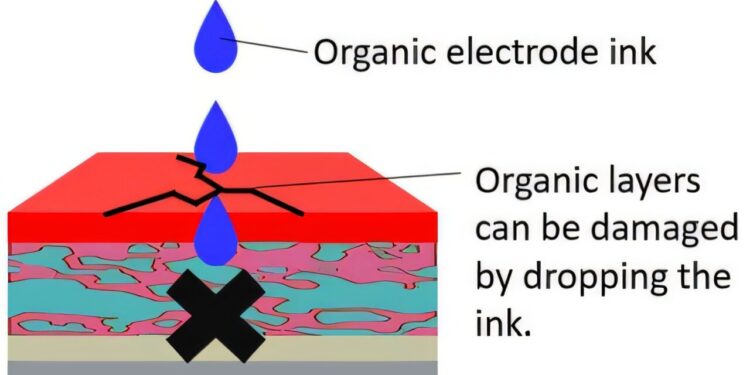Example of damage to the lower layer of elimination of solar cells formed from multilayer films when making electrodes using a solution process. Credit: University of Kanazawa
As global efforts to combat climate change continue, demand for solar energy increases. However, as solar panels based on current silicon, include a variety of dangerous substances, their elimination or recycling causes environmental impact and causes substantial costs.
The same problem is applicable to new generation film solar cells, such as perovskite solar cells, as they also contain potentially dangerous materials such as lead compounds and metal oxides. To avoid such elimination problems and reveal environment -friendly energy sources, scientists have looked for solar cells of film type composed entirely of carbon -based materials (all organic solar cells).
Without dangerous metals, these can be incinerated safely as regular plastics, which will considerably reduce the costs of environmental impact and elimination. Despite these advantages, fully organized solar cells are currently reaching a very low power conversion efficiency (PCE), around 4%at most, which is much lower than those of conventional silicon solar cells (> 27%) and perovskite solar cells (> 26%). Thus, intensive technological progress for high performance organic solar cells are necessary.
Masahiro Nakano, associate professor of the Institute of Sciences and Engineering, Chemistry Faculty of the University of Kanazawa, collaborated with scientists from Reiko Co., Ltd. And the Queen’s University in Kingston, Canada, and has now successfully developed the solar cells of all organisms with the greatest efficiency of the world. While the performance of fully organized solar cells previously organized was limited to around 4% of PCE, newly developed cells reach more than double the effectiveness of previous versions.
The work is published in the journal Advanced functional materials.
Illustration of fully organized solar cells and EOSC power conversion e ffi ciences described in this study and previous relationships. Credit: University of Kanazawa
Two major problems had previously hampered the performance of all organic solar cells. First, the availability of highly conductive transparent transparent electrodes suitable for film type solar cells is limited. Certain organic materials with high conductivity had been reported, but their preparation required strong acids, bases or high temperature reception (> 150 ° C), which could damage organic substrate films and organic semiconductive layers.
To overcome this, the research team has developed a transparent electrode based on the Pedot driver polymer: PSS. The PEDOT electrode: PSS can be manufactured at a lower temperature (80 ° C) without using acids or bases, and it demonstrates sufficient conductivity (leaf resistance: <70 Ω / SQ.) For film type cells.
The second problem is the difficulty of stacking multiple layers in the film’s solar cell system without damaging the underlying layers. In solution processes, inks in the upper layer could damage the lower layers. To solve this problem, researchers have developed a lamination method for a carbon nanotube electrode. This technique consists in forming electrodes separately on the barrier films of solar cells, then fixing them to the device, avoiding damage to lower organic films during the manufacture of electrodes.
Laminage method of the carbon nanotube electrode. Credit: University of Kanazawa
By combining the new electrode and transparent organic manufacturing method, the research team has successfully developed sunscreens entirely organized with more than double the power conversion efficiency (8.7%) of previous models (4.0%). This progression represents a crucial step towards the practical application of high performance organic solar cells.
For the future, fully organized solar cells are very promising for applications in environmental areas, such as agricultural land and portable devices. Their light and flexible nature also allows an installation in places where conventional solar panels would be impractical. The research team aims to further improve performance by improving the conductivity of organic electrodes.
More information:
Keiju Hashida et al, unlocking high performance in solar cells any organic by the development of organic electrodes without acid and high temperature treatment and its effective preparation on organic multilayer films, Advanced functional materials (2025). DOI: 10.1002 / ADFM.202419813
Supplied by the University of Kanazawa
Quote: Fully organized solar cells reach record efficiency to double the previous performance (2025, April 28) recovered on April 28, 2025 from
This document is subject to copyright. In addition to any fair program for private or research purposes, no part can be reproduced without written authorization. The content is provided only for information purposes.



